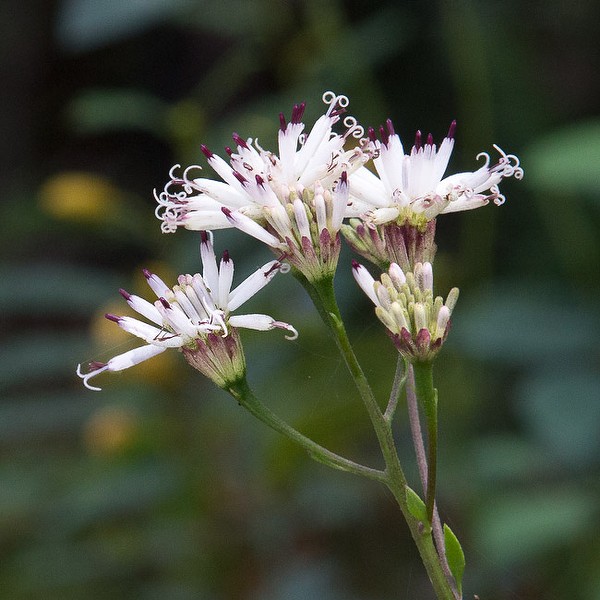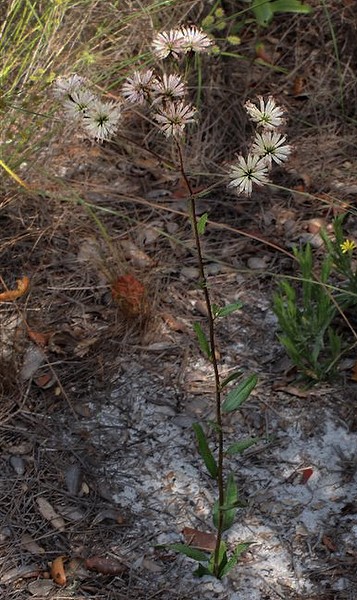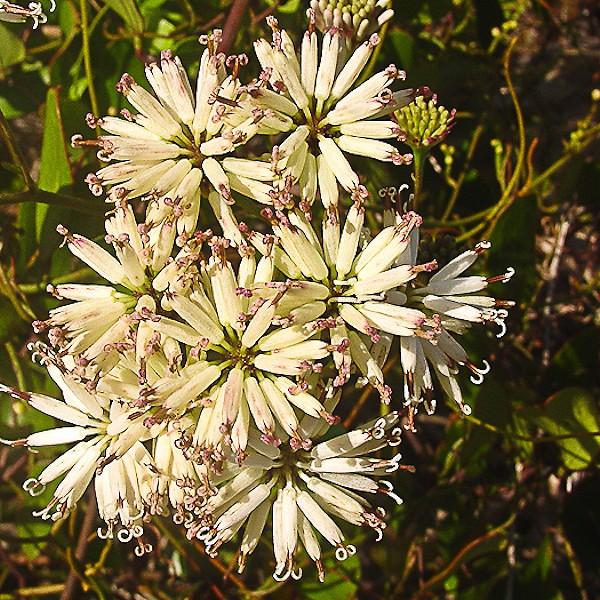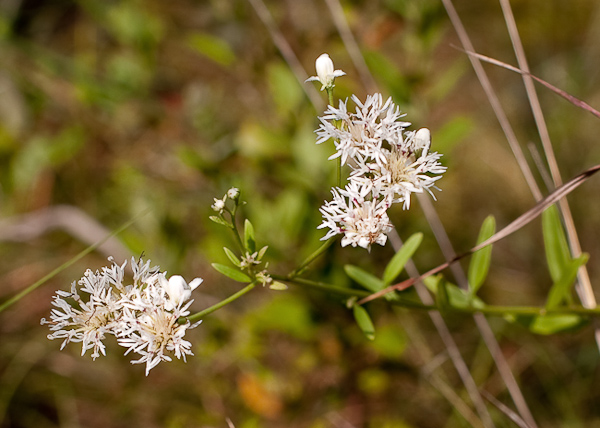Palafoxia feayi
Asteraceae
Today John and George hotfooted it through the oven-baked Saharan scrub in Seabranch State Park near Pt. Salerno, Florida. It was so torrid my shoes melted off my feet. Really. Ask John. (Well, one fell apart.) Recently a paved bicycle Autobahn made its way through the park. The concrete ribbon is wide, flat, and dang sunny, and it offers passage through dozens of scrubbish species growing in isolated clumps recovering along the disturbed trail margins. A unique “garden” view of Prairie-Clovers, Florida-Rosemarys, Golden Asters, and assorted grasses and sedges alone and uncrowded. One of the finest species to behold is Feay’s Palafox, a member of the Aster Family.
William Feay (1804? – 1879) was a Savannah, Georgia, physician turned teacher with botanical instincts in the mid 19th Century. During the Civil War Savannah Georgia was no place for a nice botanist. He scooted to Florida, where he collected the original Feay’s Palafox specimen, conceivably abetted by another botanical M.D., Alvin Chapman, of Chapman’s Oak. Just think, Feay’s Palafox is a souvenir of the War Between the States.
You don’t spend much time in scrub without seeing Feay’s Palafox, a slightly woody subshrub standing 2-8 or more feet tall with its showy white or pink flower heads. Unlike most members of its family, the heads consist entirely of “disc” flowers, that is, the sort of flowers associated with the black center of a Sunflower head. Our species hangs out in scrub or similar habitats, and seems to be fire-adapted. Recent study show its strongest root-fungal symbioses to thrive after burning followed by decline during non-burned years, although the decline could be due to the recovery of competition.
What’s intriguing about Palafoxia is its circle of relatives. We have three species in Florida: 1. Palafoxia texana, a western species with a tiny weird toehold in the Florida Panhandle. 2. Palafoxia integrifolia, almost restricted to Florida. And Palafoxia feayi, which is limited to Florida.
The rest of the genus, about 9 additional species, are all more or less desert plants in the southwestern U.S. and Mexico. This is reminiscent of Agaves, where we have two dubiously native species in Florida related to a big group in the Southwest, Mexico, and Caribbean.
That our local Palafoxia species live in Florida’s sandy scrub “desert” is no surprise then, given that they are far-flung offshoots of a posse at home in Death Valley and the Sonoran Desert. Palafoxia supports a vision of Florida scrub as a now-isolated remnant of a once-contiguous Tex-Mex arid land stretching around the Gulf, eventually divvied up by changing conditions. Similar Florida scrub-loving derelicts with Mexican roots include Scrub Jays and Gopher Tortoises.
If the Florida species of Palafoxia are spillovers from points west, do they represent one spill, or three separate splashes? The latter: Our three species are not closely related to each other. Palafoxia texana stands aloof. It does not even have the same number of chromosomes as our other two Florida species. Likewise alone is Palafoxia integrifolia; as botanists who studied it said, it is “unquestionably the oddball of the genus Palafoxia,” so odd, it used to be regarded as a separate genus.
Palafoxia feayi is allegedly most closely related to two species of the extreme Southwestern U.S., Mexico, and the Rio Grande Region.
How such an odd mixed up geographic pattern could come about boggles the brain. One thing is certain, it dates back a long time, roughly (according to the botanists cited below) some 60 million years, before the continent-spanning genus fragmented into isolated lineages from Baja California to Seabranch State Park.
This all goes to reinforce nobody’s secret: Florida scrub is vastly older than other Florida habitats, with a history all its own. When you walk in a Florida scrub, enjoy a little hint of the Tertiary Period when Mexico extended to Palm Beach, when palm trees grew in Ohio, and when Gopher Tortoises raced Jackrabbits here from Chihuahua. (Apparently the tortoise won.)
——————-
Notes:
Most of today’s data and taxonomic assessments on Palafox come from B. L. Turner and M. I. Morris, Systematics of Palafoxia (Asteraceae: Helenieae). Rhodora 78: 567-628. 1976.
Our two local species are easy to separate. Palafoxia feayi is semi-woody, well over a yard tall, and has the flower heads surrounded by linear green or purplish bracts. Palafoxia integrifolia is shorter than a yard tall; its bracts are more or less white, and narrowly elliptic.




wildflp
October 3, 2014 at 10:17 pm
Imagine my surprise to read this that was posted today, the same day I saw both Palafoxia feayi and Palafoxia integrifolia on a Wings & Wildflower Festival field trip to Seminole State Forest Warea Tract.
Uncle Tree
October 4, 2014 at 7:28 am
Who knew? Ö my goodness, George. It’s too early in the morning to learn so much. I think I could stop here, and call it a day. Great pics, John! The curly-cues on the end of the flowers, top-pic, are dainty-cute, and they make me smile. 🙂 I don’t know why, they just do. Cheerz to you two! UT
George Rogers
October 4, 2014 at 8:47 am
One more point of schoolin’ Those curly-cues are the flower’s privvy parts. Continue smiling!
George Rogers
October 4, 2014 at 8:45 am
Happy for the pretty coincidence. The Palafoxias are stunning right now. Their beauty this week prompted the species choice.
Chris Lockhart
October 4, 2014 at 11:50 pm
What a treat to catch both species of Palafoxia in the same walk! One of my favorite little scrub plants. BTW, if P. faeyi is supposed to get up to 8 ft, have you ever seen it that tall? Must be a monster plant that hasn’t been burned in decades! I usually see it in the 3-4 ft. range. Nice bit of biogeography.
wildflp
October 5, 2014 at 6:42 am
The P. feayi I saw years ago at Lake June-inWinter scrub state park was probably about 4 ft tall. Some of the ones I saw Friday could have been 5 foot if held upright, they were mostly leaning over, seemingly from the weight of the flowers.
George Rogers
October 5, 2014 at 6:38 am
Snook reach 40 pounds but I usually catch them in the 1-2 pound range.
Here is a big tall Palafox:
Martin
October 7, 2014 at 5:43 am
Hahaha! Me too, brother…
George Rogers
October 7, 2014 at 10:01 am
We’re secure enough in my fisherman-hood to admit it. A bigger problem is I never find the time any more to go try.
Chris Lockhart
October 5, 2014 at 3:42 pm
It’s great to know an honest angler! 🙂
Kathy Petteruti
April 9, 2017 at 4:36 pm
Thanks for the learning cues. Do enjoy your blogs